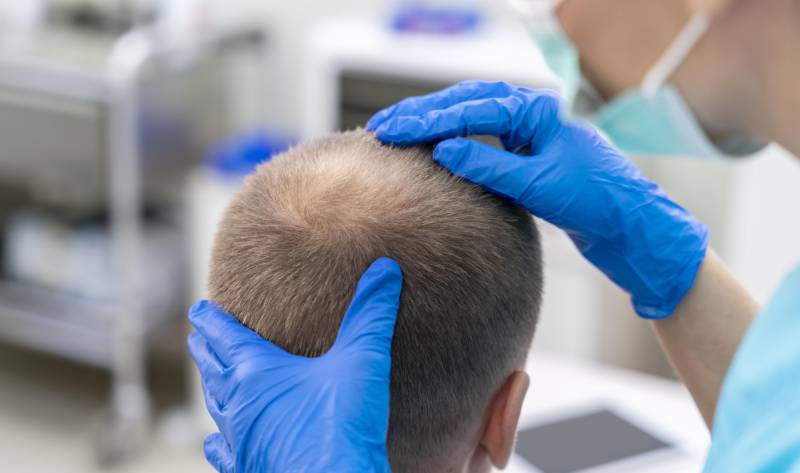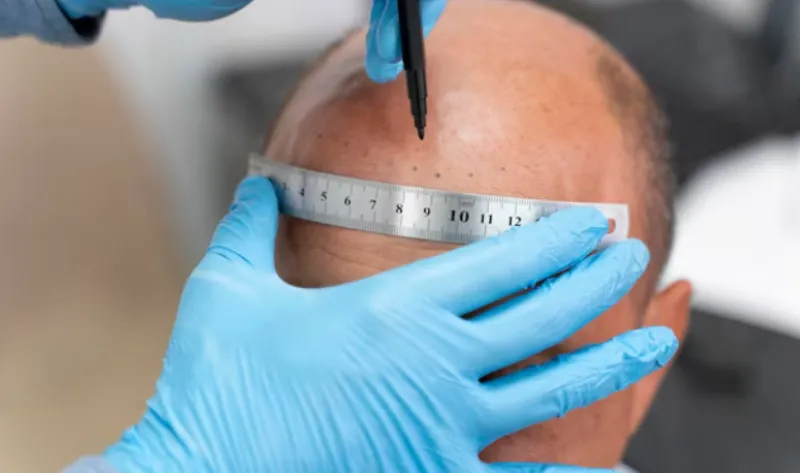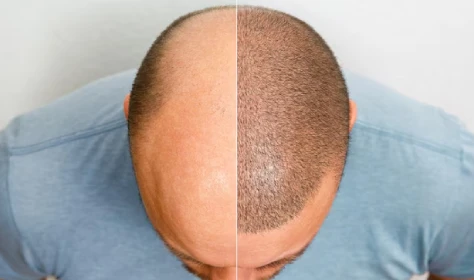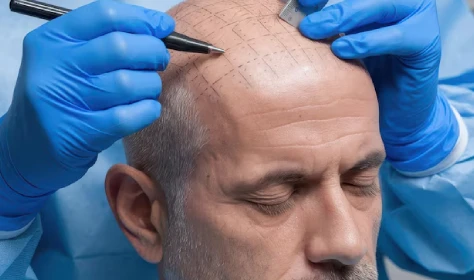Hair fall treatment in Delhi and cost of hair fall treatment in delhi.
Hair fall and hair thinning can be scary. Watching hair shed off every time one combs, on the room floor, on the pillow each morning, or in the bathroom during a head wash can be very disturbing. Looking in the mirror and realizing that the hair isn’t what it used to be once upon a time, thick and desirable, and seeing empty patches or bald spots on the scalp, pulls the confidence down. It can be so heartbreaking that it disrupts one’s personal life. An individual facing it cannot focus on their work or studies. One also tries to avoid social events and meeting people. One ends up worrying about our hair all the time, even losing sleep over it.
Therefore, a hairfall control solution is absolutely essential. Effective hairfall treatment can elevate one’s looks, lift one's mood, and thereby improve the quality of one’s life. However, the biggest hurdle when searching for hairfall treatment is: Which treatment is genuinely effective?
We often rely on Google to find solutions to all our problems. But when we look up the Internet, we see hundreds and thousands of solutions that claim to be ‘100% effective’—again, confusion.
So now we are going to talk about solutions that really work—solutions for hair fall control that have been scientifically tested and proven effective.
1. Min-oxi-dil: Yes, friends. Min-oxi-dil lotion is the number one effective hair fall control treatment, proven by thousands of scientific studies to work, unlike vague serums and oils that have no proof of efficacy. Min-oxi-dil works in about 70 % of people to increase the thickness and number of anagen, i.e., growing hair. It is a lotion that has to be applied once or twice a day. The exact preparation and dosing can best be prescribed by a dermatologist.
However, there are certain side effects of min-oxi-dil, or rather, the downside.
Many people think min-oxi-dil has very high side effects. However, we must remember that it is effective in controlling hair loss, and we must use it before we lose a lot of hair and regret not using it earlier.
COST: A bottle of minoxidil costs anywhere between Rs 600 to 1200, depending upon the formulation and ingredients.
2. P-R-P (pl-ate-let-rich pl-as-ma) or GFC ( growth factor concentrate) therapy for hair growth: P-R-P for hair loss is now a very common and safe treatment in clinics worldwide. This is a procedure wherein a blood sample is taken and centrifuged so that pla-tel-ets get extracted, which are then injected into areas of hair thinning and hair loss. We now have tons of scientific evidence that platelets are rich sources of growth factors, i.e., specific proteins present in our platelets.
These growth factors are VEGF ( vascular endothelial growth factors), EGF (epidermal growth factors), FGF ( fibroblast growth factors), and KGF (keratinocyte growth factors). They stimulate the growth of new blood vessels, new collagen and hair root cells, thus causing existing roots to produce thicker and healthier hair that will grow for more extended periods. This eventually increases hair density as the hair number and thickness increase.
Growth factor concentrate (GFC) for hair is a more refined version of P-R-P wherein instead of injecting pl-ate-lets (like in P-R-P), the growth factors are extracted from pla-tel-ets and directly injected.
The aim of both GFC therapy for hair loss and P-R-P is to promote hair growth.
COST: The cost of GFC therapy for hair ranges between Rs. 7000 and Rs. 17000, depending upon the kit being used, the doctor’s experience, and the years of establishment of the clinic.
3. Fin-aste-ride: The fact that DHT (di-hydro-test-oste-rone) causes loss of scalp hair and growth of body hair has led to the invention of this drug, which prevents the conversion of tes-tos-ter-one to DHT, by blocking the enzyme 5 alfa reductase. This, in turn, reduces the production of DHT, thus saving scalp hair. What we now know about DHT and hair is that only some parts of the scalp hair are sensitive to DHT in varying degrees. This sensitivity is acquired genetically, which is why And-ro-genetic Alopecia or Male/female pattern hair loss is acquired genetically and runs in the family. Also, it can be acquired from the mother or father’s side. So, one can get it from one's father, mother, uncles, or even grandparents. One also needs to remember that though it is genetic, the age of onset and degree of severity of hair loss depends upon one’s lifestyle factors such as diet, sleep, stress, etc.
Fin-aste-ride is a tablet that has to be taken daily. Since it reduces DHT in the body, it can have some side effects. DHT serves other purposes in the body, such as sexual health. Hence, a reduction in DHT levels can cause a reduction in sex drive, erectile dysfunction, or some mood swings. Fortunately, the side effects are reversible once one stops the medication.
COST: A strip of 30 tablets can cost around 300 Rs a month’s dose.
4. LLLT or Low-level Laser Therapy: Low-level laser light between wavelengths of 650 nm to 900 nm, is used in LLLT. The laser light is delivered at very low energies to cause stimulation of hair roots. Low-level laser for hair growth can be delivered through different methods such as laser cap, laser helmet or laser comb. Of these, the most popular is the laser helmet. It is a use at home device which has to be worn for about 30 minutes thrice a week. It is thought to increase blood supply around the roots and stimulate the growth factors, eventually causing an increase in hair density. Though we do not have sufficient scientific evidence that it works, however, the good part about it is that it has no side effects, it is not a painful process, and it can easily be used at home without having to visit a clinic. Because of these advantages, there is no harm in using the Low-level laser helmet for hair fall control, as it might prove beneficial is some people.
COST: A laser helmet typically costs between 30000 and 1 lac, depending on your brand.
5. Dermaroller: Dermaroller for hair fall control is a good device to stimulate the scalp, increase blood circulation, induce some hair growth factors, slow down ageing of hair cells, and, most importantly, increase sensitivity to min-oxi-dil. However, there are some downsides.
Using a dermaroller on hair can make your hair rough and can break it as well. Many people using a dermaroller complain that their hair has become rough and frizzy. Many people feel that while using a dermaroller, their hair gets entangled in the dermaroller and gets pulled off or breaks. The process is painful, as thousands of needle pricks are made on the scalp. This is why we suggest getting the treatment done by a dermatologist who can first numb the area and also carefully do the procedure to avoid hair damage.
COST: A dermaroller costs around 500 to 2000 rs. A typical session in the doctor’s clinic can cost between 5000 and 10,000 Rs. per sitting.
6. Redensyl, Procapil, Capixyl, Anagain: These are peptides that are the new entry into the market. Though we do not have sufficient evidence that they work, some people experience some improvement in hairfall and feel that their hair's texture has improved. The best part about using these is that they are very comfortable to use: no stickiness, no itching, no dandruff as compared to min-oxi-dil. Hence, it is often the first management line for initial hair loss stages. If they work well and are good, else more effective treatments can be looked into.
COST: A bottle lasting a month will cost anywhere from rs 500 to rs 2000.
7. Mesotherapy: is one of the early treatments for hair loss. It is a process where some medications or serums are infused into the scalp skin using microneedling, needleless mesotherapy, or injections. Depending upon the medications that are infused, it may be effective. However, it is quite painful, and chances of allergic reaction exist. Therefore, it is not very popular these days.
8. Exosomes for Hair Fall Control Treatment: Exosomes are certain cytokines that are secreted within the cells and then extruded, that act as signalling agents. These substances signal the growth and multiplication of cells, hence acting as growth inducers. If used correctly, exosomes can stimulate weak and dormant hair roots to get activated again and start making thick, strong hair. Again, like many other treatments, there is insufficient evidence to support its use in and-ro-gene-tic alopecia i.e., as a hair fall treatment.
9. Regenera: This is a relatively new treatment in which a few roots of hair are taken, and stem cells are extracted from them and injected back into the scalp. The idea behind this treatment is to provide active stem cells to the hair roots to stimulate regrowth. Stem cells are nondifferentiated cells that can develop into hair root cells and push start the hair growth process.
COST: A typical sitting of Regenera will cost anywhere around Rs. 30,000 to 50,000
10. Specialized Differentiating Cell Therapy for Hair Loss: Specialized Differentiating Cells for hair fall treatment can be derived through two means. One would derive specialized differentiating cells from one’s fat (adipocytes) from the abdomen area. The other is plant-based cells. While the cells from the fat are extracted from the individual's fat and injected, plant-specialized differentiating cells are pre-packaged and come in sealed vials. Now, whether these cells are active and viable and whether these will be sufficiently effective at stimulating hair growth is yet not fully understood. Also, concerns about car-cino-geni-ci-ty are floating, so this treatment isn’t too popular.
11. Alma TED: This is a new technology that is delivering very promising results. The mode of action of ALMA TED device is that with the help of ultrasound waves it helps to infuse certain growth peptides into the scalp. The best part is that the treatment is painless, unlike P-R-P or GFC, dermaroller or regenera or specialized differentiating cell treatment, since all these are injectable therapies, unlike Alma TED. It may shape the future of hair fall treatment in Delhi and the World.
We need to know that only min-oxi-dil and Fin-aste-ride are proven to work. The rest have variable results. However, any treatment that doesn’t have side effects, such as GFC, for hair loss control can definitely be tried.
Last but not least, a good lifestyle is paramount to keeping our hair healthy and also to get a better response to hair loss treatments. So it's essential to sleep early, wake up early, eat healthy, and exercise. To get personalised advice or treatment, book a consultation at Chandra Hair Transplant Clinic. The clinic was founded by the best hair fall doctor in Delhi, Dr. Urvashi Chandra. Pay a visit now!



